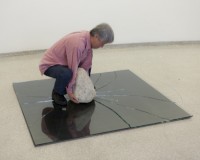LEE UFAN
Ли Уфан
李禹煥
Breaking Glass
source:
Lee, a 75-year-old Korean who moved to Japan at the age of 21 and now divides his time between Kamakura (near Tokyo) and Paris, is showing about 90 works dating from the 1960s to now, distributed throughout the rotunda and in two side galleries. His long history is little known in the U.S., but he has shown extensively in Europe and is, you could fairly say, revered in Asia. Lee studied philosophy (to “find himself” as a foreigner in Japan, he modestly explains). He came to local attention as a member and chief theorist of the Mono-ha movement, producing a number of essays in Japanese art magazines.
Mono-ha (“School of Things”), which fostered an Arte Povera-like engagement with materials, was popular between 1968 and ’72. It began as a sculpture movement, but Lee extended its literalness to painting. Loading his brush, he patted marks in a row until the paint was exhausted, then dipped the brush again and repeated. He took the same approach with lines continued until the brush was empty.
Through the years Lee’s concept has been consistent, but scale, composition, color and control have varied in the paintings, which have grown larger and more spacious. His recent examples, just as physical, are expanses of emptiness featuring a single heavy stroke made with a wide brush.
“My work is very pure but very open,” Lee told me, and he hopes visitors will interpret it as a bodily, rather than intellectual, experience. “Breaking glass is something any child can do, but when an artist does it, there’s more.” Speaking sometimes in English and sometimes through an interpreter, Lee said that he tries not to create with too much control, because he regards his work as a cooperative interaction of materials, highlighting their natural characteristics.


